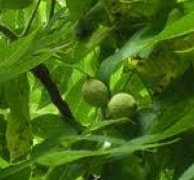Walnut
The leaves of the Walnut tree, when slightly rubbed, emit a rich aromatic odour, which renders them proof against the attacks of insects. Qualities of this odoriferous sort commended the tree to King Solomon, whose "garden of nuts" was clearly one of Walnuts, according to the Hebrew word eghoz. The longevity of the Walnut tree is very great. There is at Balaclava, in the Crimea, a Walnut tree believed to be a thousand years old.
Added Mar 5, 2011
| 7,128 Reads
The Walnut tree is known of aspect to most persons throughout Great Britain as of stately handsome culture, having many spreading branches covered with a silvery grey bark, which is smooth when young, though thick and cracked when old. The flowers occur in long, hanging, inconspicuous spikes or catkins, of a brownish green colour. This tree is a native of Asia Minor, but is largely grown in England. The Greeks called it "Karuon," and the Latins "Nux." Its botanical title is Juglans regia, a corruption of glans, the acorn, jovis, of Jupiter, or the "royal nut of Jupiter," food fit for the Gods! Its fruit is also named Ban nut, or Ball nut, and Welsh nut, or Walnut-- the word Wal, or Welsh, being Teutonic for "stranger." "As for the timber," said Fuller, "it may be termed the English Shittim Wood." The London Society of Apothecaries has directed that the unripe fruit of the Walnut should be used pharmaceutically on account of its worm-destroying virtues. It is remarkable that no insects will prey on the leaves of this tree. In good seasons the produce of nuts is weighty enough to pay the rent of the land occupied by the trees. The vinegar of the pickled fruit makes a very useful gargle for sore throats, even when slightly ulcerated: and the green husks, or early buds of the blossom, being dried to powder, serve in some places for pepper. The kernel of the nut (or the part of the inside taken at dessert) affords an oil which does not congeal by cold, and which painters find very useful on such account. This oil has proved useful when applied externally for troublesome skin diseases of the leprous type. Indeed, the Walnut has been justly termed vegetable arsenic, because of its curative virtues in eczema, and other obstinately diseased conditions of the skin. The tincture when made (H.) from the rind of the green fruit and the fresh leaves, with spirit of wine, and given in material doses, will determine in a sound person a burning itching eruption of the skin, of an eczematous character, lasting a long time, and leaving the parts which have been affected afterwards blue and swollen. Reasoning from which it has been found that the tincture, in a reduced form, and of a diminished strength, proves admirably curative of eczema, impetigo, and ecthyma. The unripe fruit is laxative, and of beneficial use in thrush, and in ulcerative sore throat. The leaves are said to be anti-syphilitic: likewise the green husk, and unripe shell. Obstinate ulcers may be cured with sugar well moistened in a strong decoction of the leaves. Well kept, kiln-dried Walnuts, of some age, are better digested than newer fruit; in contrast to old gherkins, about which it has been humorously said, "avoid stale Q-cumbers: they will W-up." In many parts of Germany the peasants literally subsist on Walnuts for several months together; and a young farmer before he marries has to own a certain number of flourishing Walnut trees. The bark or yellow skin which clothes the inner nut is a notable remedy for colic, being given when dried and powdered, in a dose of thirty or forty grains mixed with some carminative water; and the same powder will help to expel worms. According to the Salernitan maxim, if the fruit of the Walnut be eaten after fish, the digestion of the latter is promoted:-- Post pisces nux sit: post carnes case us esto. Or, "Take Welsh nuts after fish: take cheese after flesh meat." But with some persons coughing is excited by eating Walnuts. The roots, leaves, and rind yield a brown dye which is supposed to contain iodine, and which gipsies employ for staining their skins. It also serves to turn the hair black. A custom prevails (says a Latin sentence) among certain country folk to thrash the nuts out of their husks while still on the trees, so that they may grow more abundantly the following year. In allusion to which practice the lines run thus:-- "Nux, asinus, mulier, simili sunt lege ligata; Haec trieo nil fructûs faciunt si verbera cessant." "A woman, a donkey, a walnut tree-- The more you beat them, the better they be." It is a fact, that by acting in this way, the barren ends of the branches are knocked off, and fresh fruit-bearing twigs spring out at each side in their stead. Walnut cake, after expressing out the oil from the kernels, is a good food for cattle, these kernels being the crumpled cotyledons or seed leaves. They contain oil, mucilage, albumen, mineral matter, cellulose, and water. The rook has a most abiding affection for Walnuts. As soon as there is any fruit on the trees worth eating, this bird finds it out, and brings it to the ground, choosing only those nuts which are soft enough for him to penetrate. Ovid has left a charming little poem, Nucis Elegia--the plaint of the Walnut tree--because beaten with sticks and pelted with stones, in return for the generosity with which it bestows on mankind its fair produce. A valuable medicinal Spirit is distilled by druggists from the fruit of the Walnut. It is an admirable remedy for spasmodic indigestion, and to relieve the morning sickness of pregnancy. A teaspoonful of the spirit (Spiritus nucis juglandis) may be given with half a wine-glassful of water every hour or two, for most forms of sickness, and the dose may be increased if necessary. "Nucin," or "juglon," is the active chemical principle of the several parts of the tree and its fruit. The leaves, when slightly rubbed, emit a rich aromatic odour, which renders them proof against the attacks of insects. Qualities of this odoriferous sort commended the tree to King Solomon, whose "garden of nuts" was clearly one of Walnuts, according to the Hebrew word eghoz. The longevity of the tree is very great. There is at Balaclava, in the Crimea, a Walnut tree believed to be a thousand years old. The shade of the Walnut tree was held by the Romans to be baneful, but the nuts were thought propitious, and favourable to marriage as a symbol of fecundity. The ceremony of throwing nuts, for which boys scrambled at a wedding, was of Athenian origin:-- "Let the air with Hymen ring Hymen! Io! Hymen sing! Soon the nuts will now be flung: Soon the wanton verses sung." --Catullus. In Italy this is known as the "Witches tree." It is hostile to the oak. The leaves of the American Black Walnut tree, which grows naturally in Virginia, are of the highest curative value for scrofulous diseases and for strumous eruptions. Chronic, indolent sores have been healed by these after every other remedy has failed. The parts should be washed several times a day with a strong decoction of the leaves, and an infusion of the same should be taken internally; also of the extract made from the leaves, four grains in a pill each night and morning. For such purposes the leaves of our English Walnut are almost equally efficacious. To make an infusion one ounce should be used to twelve ounces of boiling water. For a syrup mix eight grains of the extract with an ounce of simple syrup: and give one teaspoonful of this twice a day with water. Also apply to any sore some of the powdered leaves on lint soaked in the decoction. For scrofulous joints, or glands, this treatment is invaluable. A green English Walnut, boiled in syrup and preserved in the same, is an excellent homely remedy for constipation. It will be noticed that the fruit becomes black by boiling. The Chinese put the raw kernels into their tea to give it a flavour. By the Romans Walnuts were scattered among the people when a marriage was celebrated, as an intimation that the wedded couple henceforth abandoned the frivolities of youth. The "titmouse" walnut produces very delicate fruit, rich in oil, and with thin shells, so that the little creatures can pierce the husks and shells while the fruit is still on the bough. Nuts of various kinds, being charged with carbon and oil, are highly nutritious, but on account of this oil abounding, they are not readily digested by some persons. In Southern Europe, the Chestnut is a staple article of food, The title "nut" signifies a hard round lump, from nodus, a knot. Leigh Hunt wrote meaningly of the "inexorably hard cocoa nut-- milky at heart." In Devonshire a plentiful crop of hazel nuts is believed to portend an unhealthy year:-- "Many nits (nuts) Many pits (graves)." When eating almonds and raisins at dessert we get the nitrogenous food of the nuts with the saccharine nourishment of the grapes.
Added Mar 5, 2011
| 7,128 Reads
Share The Magic ...
The GoE MONEY!!! Course - A Course In Real MONEY MAGIC!
|





















